Previously, the patient had no abnormal symptoms for more than 20 years. The results of the magnetic resonance imaging (MRI) determined that the patient's left breast implant was torn about 3 mm, the bottom of the implant was effusion, and the breast implant capsule was degenerated.
The patient was treated by Dr. Hoang Thi Phuong Lan, Tam Anh General Hospital, using a central suction system to completely remove the silicone and mucus. After that, the entire breast implant was surgically removed, the fibrous capsule was peeled off, and tissue samples were taken for pathological analysis to avoid tissue inflammation and granulomas (silicoma) eroding healthy tissue.
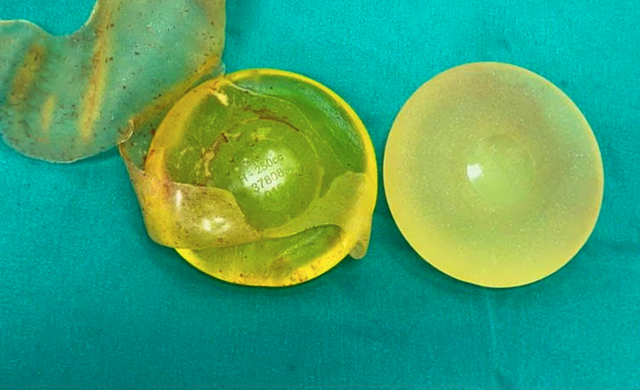
Breast implants after surgical removal
PHOTO: BSCC
After surgery, the patient was alert, had no fever, the surgical wound was dry, the drainage was removed after 4 days, the patient's health was stable and he was discharged. At the same time, the patient was instructed to closely monitor and take good post-operative care, change the bandage every other day, keep the surgical wound dry, and remove the stitches after 10 days. Wear a chest shaping bra 24/7 for the first month to help the tissue heal stably; avoid strenuous exercise, lifting, leaning on the arms, and stretching.
Many cases of breast implants being found to be torn
Doctor Lan said that cases of ruptured breast implants that come to Tam Anh General Hospital for treatment account for more than 50% of customers who are repairing the consequences of cosmetic surgery, most of whom have had breast implants for 7-20 years.
The average lifespan of a breast implant is about 10-15 years, depending on the type of implant and the patient's constitution. After this time, the implant may degenerate, leak or rupture, and the silicone may spill into the chest cavity. At this time, the patient may have an immune response disorder, swollen lymph nodes, redness, and even a tumor may form around the implant, or worse, deformity and abscess in the chest area.
Modern breast implants are durable and strong, but they do not last forever. After 10 years, the implant recipient needs to have regular ultrasound and MRI checks to detect early the risk of rupture or fibrous capsule inflammation.
"In particular, some cases like the female patient above, although there are no obvious symptoms, if not detected and treated promptly, can lead to serious consequences such as chronic inflammation, breast deformities, or deep tissue infections that are difficult to treat," Dr. Lan shared.
After 10 years of breast implant placement, periodic check-ups should be performed 1-2 times/year.
Dr. Lan noted that after 10 years of breast implant placement, periodic check-ups should be performed 1-2 times/year using ultrasound or MRI. After 15 years, consideration should be given to replacing or removing the implant, especially if signs of degeneration, fibrosis, or abnormal fluid are detected.
Breast implant patients should not delay examination even if there are no symptoms. Breast implant rupture can develop silently for many years. It is necessary to choose a medical center with a cosmetic surgery department, fully equipped with imaging equipment and a standard operating room system to handle the situation thoroughly and safely.
Source: https://thanhnien.vn/rach-tui-nguc-sau-22-nam-nang-cap-vong-1-silicon-tran-ra-khoang-nguc-185250731183802339.htm












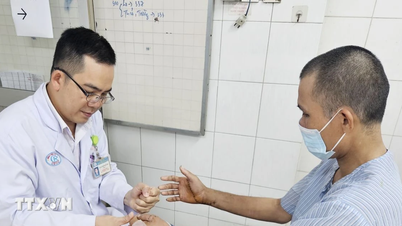

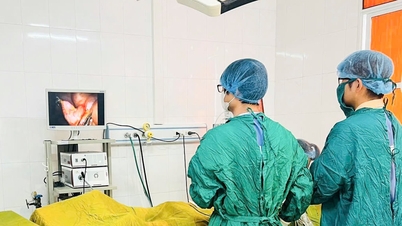













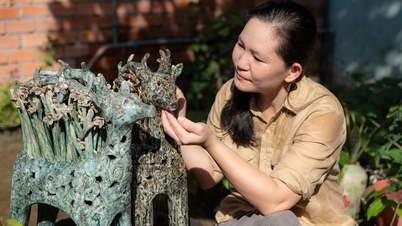





















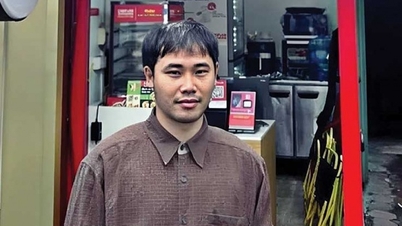




















![[Infographic] Vietnam's stock market exceeds 11 million trading accounts](https://vphoto.vietnam.vn/thumb/402x226/vietnam/resource/IMAGE/2025/11/09/1762677474332_chungkhoanhomnay0-17599399693831269195438.jpeg)




















![Dong Nai OCOP transition: [Part 2] Opening new distribution channel](https://vphoto.vietnam.vn/thumb/402x226/vietnam/resource/IMAGE/2025/11/09/1762655780766_4613-anh-1_20240803100041-nongnghiep-154608.jpeg)













Comment (0)